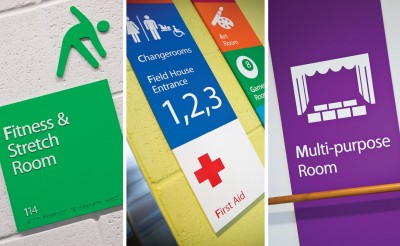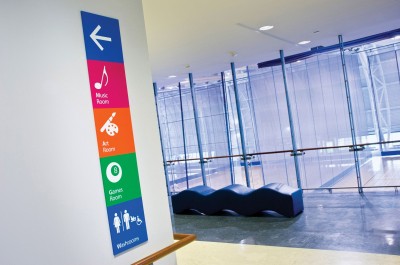Providing guidance through the abilities centre
by all | 7 February 2014 8:30 am
 [1]
[1]Photos courtesy SLD
By Sheryl Keller Ziesmann
The Abilities Centre, a new multi-purpose facility in Whitby, Ont., has been designed to provide full accessibility for people of all ages and abilities. In the works for approximately a decade before opening in June 2012, it represents an ambitious hope to change Canada’s social fabric through inclusiveness, by encouraging able-bodied and physically and mentally challenged people to integrate while pursuing recreation, athleticism, the performing arts, life skills education and other activities.
As part of the environmental graphic design (EGD) scheme for the 11,613-m2 (125,000-sf) recreational centre, Toronto-based firm Shikatani Lacroix Design (SLD) was tasked with creating a wayfinding program that would not only simplify navigation for everyone through accessible signage, but also take it as far as possible, surpassing typical expectations to truly welcome, include and empower visitors in the spirit of the overall project, which is intended as a full-scale accessibility showcase to Canada and, indeed, the world.
By meeting and exceeding existing accessibility codes, the signs would help uphold the Abilities Centre’s mission to improve people’s quality of life by enhancing the visitor experience.
 [2]
[2]The multi-purpose facility opened in Whitby, Ont., in June, 2012 after a decade of planning.
Innovating in accessibility
The $40-million building was developed with planning and funding from all levels of government, including federal, provincial (Ontario), regional (Durham) and municipal (Whitby), along with contributions from individuals and corporations. The project’s core values would include respect, understanding, co-operation, education and innovation.
The 7,897-m2 (85,000-sf) main floor features a running track that circles several basketball courts. A rail was installed next to the track for both the visually impaired and people with mobility issues. The courts’ hardwood flooring is often covered with a more durable plastic surface to support wheelchair rugby games.
The main floor also houses fitness rooms with workout machines specially designed to accommodate wheelchairs. Weight-lifting systems use compressed air, rather than actual weights. Wall-mounted TVs display closed captioning (CC).
The second floor is dedicated to ‘softer’ recreation, with rooms for music, theatre, arts, games, cooking and education. A special ‘test apartment’ space, for example, helps people who have never lived alone before learn how to run a home, while kitchen counters are positioned lower to accommodate wheelchair users.
Intuitive wayfinding
Having previously worked on wayfinding projects for recreation centres in Brampton, Ont., SLD answered a request for proposals (RFP) for the Abilities Centre and was subsequently hired by the architects at Aecon Canada. The budget was not big and there was not much time left for the project, as the building had already been constructed.
It was a major creative opportunity on a large scale, but given the tight timelines and no chance to test out rough concepts, the designers had to present ideas they already knew could work. After a tour and an initial briefing with the Abilities Centre’s management and the architects, they were able to come back with several options for the sign system, one of which was then chosen by the client with minimal changes.
 [3]
[3]The main floor’s fitness rooms feature workout machines specially designed to accommodate wheelchairs.
Since the cognitive abilities of all users would range dramatically, SLD developed a straightforward wayfinding strategy that would rely on three main tools: type, icons and colour coding. Production began quickly, with flat, computer-generated designs turned into dimensional reality by King Architectural Products in Bolton, Ont., which handled both fabrication and installation.
Type
The signs were designed for maximum legibility, using large print, and to be read by touch, featuring both tactile characters and braille dots. The system includes wall and door signs, wall-mounted directional signs, elevator directories and amenity signs.
King used photopolymer etching to create permanent tactile and braille features, rather than applying additional material onto the signs that could be picked off over time.
Pictograms
Universally recognizable pictograms were added for quick visual recognition. Different types of rooms, for example, are identified with simple icons on 279 x 279-mm (11 x 11-in.) signs.
 [4]
[4]The second floor is dedicated to ‘softer’ recreation, including the arts. Yellow flooring helps guide visually impaired users.
 [5]
[5]Floor-to-ceiling panels identify rooms with distinctive pictograms and colours.
Pictograms were extended to some non-signage features, too, such as elongated buttons on corridor walls featuring the international symbol of access (i.e. a person in a wheelchair), which are pushed to open doors as needed. These are designed so guide dogs can press them, too.
Colour coding
Colours were used to code door signs, floor-to-ceiling panels with large icons and other wayfinding components throughout different areas to help make the navigation process more intuitive and the room locations more easily remembered.
This strategy dovetailed well with the building’s architectural approach, which specified the heavy use of yellow flooring to help guide users, as research shows yellow is one of the last colours people can see clearly when they are gradually going blind.
Looking to the future
The Abilities Centre may become a major site for the track and field events of the 2015 Parapan American Games, where athletes with disabilities will compete shortly after the Pan American (Pan Am) Games.
In the meantime, the facility is partnering with universities and colleges to bring in researchers, so evidence-based decisions can be made about what works and what could be improved. Though the building itself is complete, its accessibility features will continue to evolve along with programming and interaction.
Sheryl Keller Ziesmann is the wayfinding design director for Shikatani Lacroix Design (SLD). For more information, visit www.sld.com[6].
- [Image]: http://www.signmedia.ca/wp-content/uploads/2014/02/SL_WhitbyAbilitiesCentre-3UP.jpg
- [Image]: http://www.signmedia.ca/wp-content/uploads/2014/02/SL_WhitbyAbilitiesCentre34.jpg
- [Image]: http://www.signmedia.ca/wp-content/uploads/2014/02/SL_WhitbyAbilitiesCentre33.jpg
- [Image]: http://www.signmedia.ca/wp-content/uploads/2014/02/SL_WhitbyAbilitiesCentre20.jpg
- [Image]: http://www.signmedia.ca/wp-content/uploads/2014/02/SL_WhitbyAbilitiesCentre18.jpg
- www.sld.com: http://www.sld.com
Source URL: https://www.signmedia.ca/providing-guidance-through-the-abilities-centre/